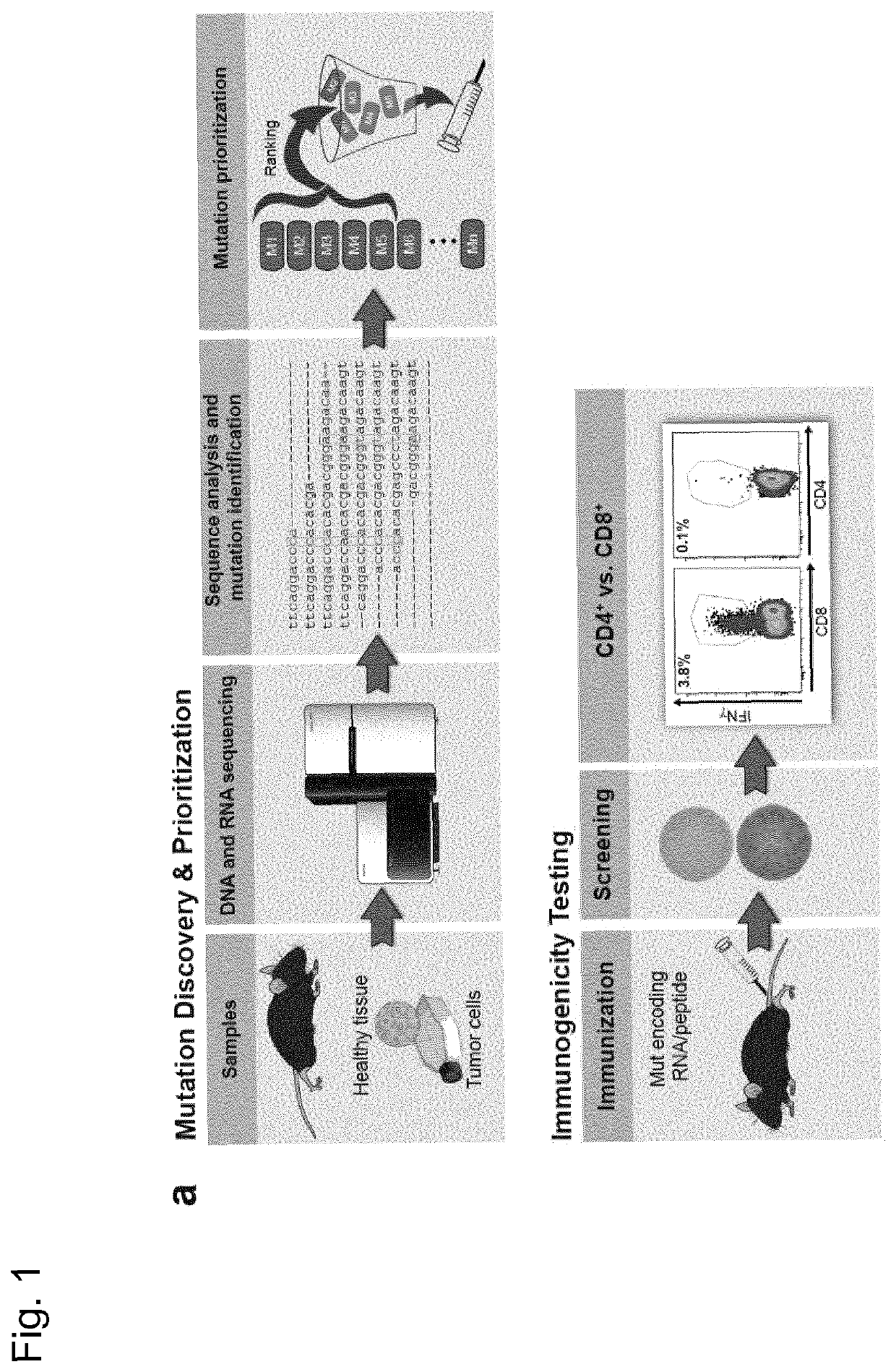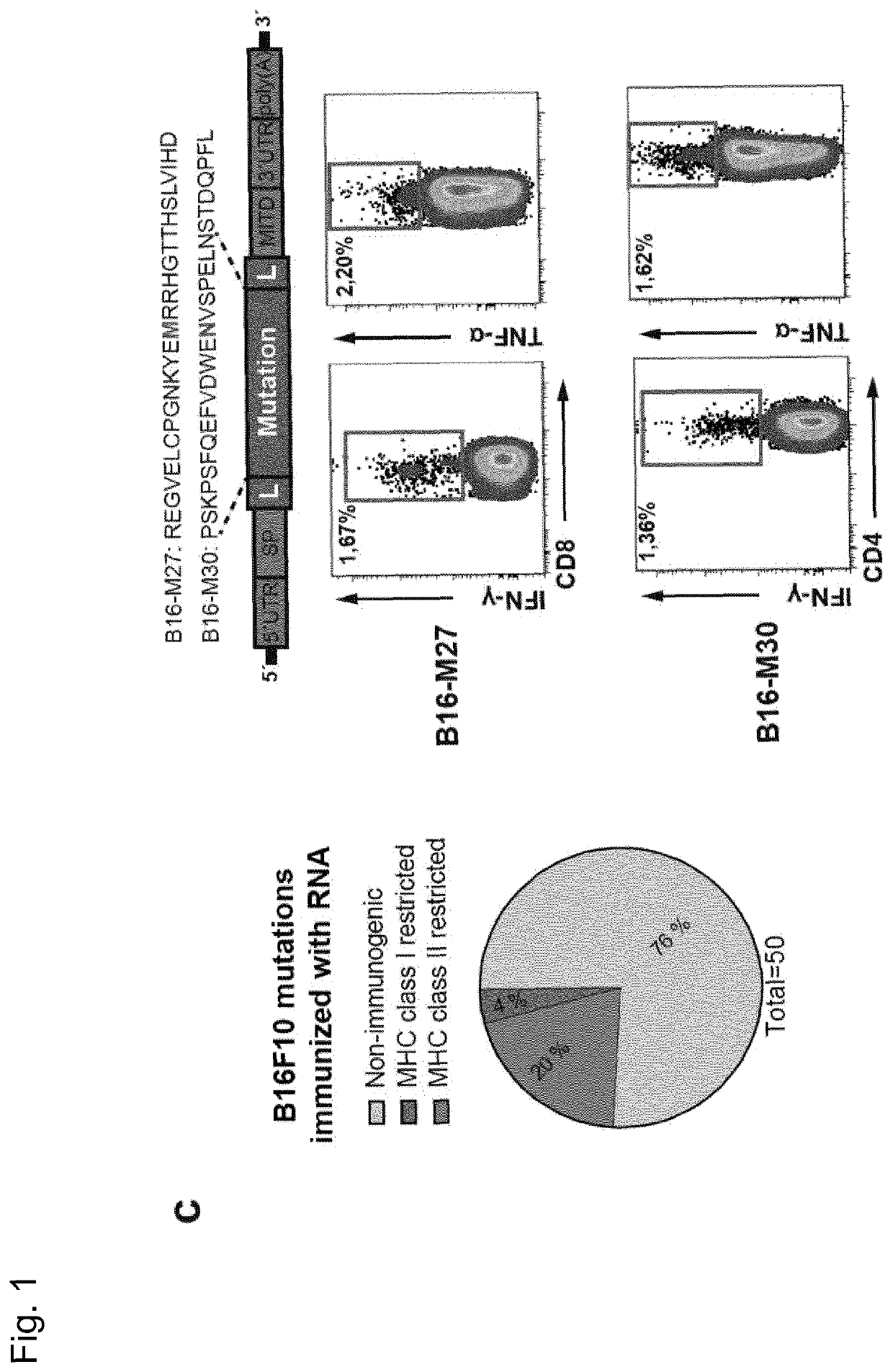Predicting T cell epitopes useful for vaccination
a technology vaccines, applied in the field of methods for predicting t cell epitopes useful for vaccination, can solve the problems of hampered systematic use of mutations in vaccine approaches, and achieve the effect of preventing the spread of t cell epitopes
- Summary
- Abstract
- Description
- Claims
- Application Information
AI Technical Summary
Benefits of technology
Problems solved by technology
Method used
Image
Examples
example 1
and Methods
[0263]Samples. Female 8-12 week old C57BL / 6, BALB / c mice (Janvier Labs) and C57BL / 6BrdCrHsd-Tyrc mice (B6 albino, Harlan) were kept in accordance with federal policies on animal research at the University of Mainz. B16F10 melanoma cell line, CT26 colon carcinoma cell line and 4T1-luc2-tdtomato (4T1-Luc) cells were purchased in 2010, 2011 and 2011 respectively (ATCC CRL-6475 lot #58078645. ATCC CRL-2638 lot #58494154, Caliper 125669 lot #101648) and maintained as suggested by the supplier. Firefly luciferase expressing CT26-Luc and B16F10-Luc cells were lentivirally transduced. Master and working cell banks were generated, of which third and fourth passages were used for tumor experiments.
[0264]Next generation sequencing and data processing was described previously (Castle. J. C., et al., Cancer Res 72, 1081 (2012); Castle, J. C, et al., BMC Genomics 15, 190 (2014)). In brief, exome capture from mouse tumor cells and tail tissue samples of BALB / c or C57BL / 6 mice were seque...
example 2
II Restricted T Cell Epitopes in Neo-Epitope Vaccines
[0276]A. Characterization or T Cell Subtypes Reactive Against Mutated Epitopes
[0277]Recently, we described a workflow for comprehensive mapping of non-synonymous mutations of the B16F10 tumor by NGS (FIG. 1a) (Castle. J. C, et al., Cancer Res 72, 1081 (2012)). Tumor-bearing C57BL / 6 mice were immunized with synthetic 27mer peptides encoding the mutated epitope (mutation in position 14), resulting in T cell responses which conferred in vivo tumor control. In continuation of that work, we now characterized the T cell responses against the mutated epitopes starting with those with a high likelihood of MHC I binding. Mice were vaccinated with synthetic 27mer mutated epitope peptides (FIG. 1b upper right). Their splenocytes were tested in IFN-γELISpot to identify immunogenic mutations for further analysis of subtype and cytokine expression (FIG. 1a). About 30% of mutated epitopes were found to induce mutation reactive cytokine secreting...
example 3
of Mutations Having Anti-Tumor Immunity
[0303]For selecting / ranking amino acid sequence modifications one may proceed as follows:[0304]1. Within a given list of non-synonymous point mutations, compute a peptide sequence which has the mutated amino acid in the middle and is flanked by up to 13 amino acids on the N and C-terminal end, respectively; this will be called 27mer in the following text (the length for each flanking sequence may be smaller than 13 amino acids when the mutation is close to the N or C-terminus of the whole protein)[0305]2. Compute MHC class II binding prediction consensus scores (e.g. using the IEDB T-cell prediction tools [Wang P. et al. (2010) BMC Bioinformatics. 11:568. PMID: 21092157. http: / / tools.immuneepitope.org / mhcii / ]) for each overlapping 15 nt long subsequence of each 27mer; the best (=lowest) score is assigned to the whole 27mer[0306]3. Compute the expression (preferably in RPKM units [Ali Mortazavi, et al. (2008) Nature Methods 5, 621-628]) of the g...
PUM
| Property | Measurement | Unit |
|---|---|---|
| time | aaaaa | aaaaa |
| time | aaaaa | aaaaa |
| time | aaaaa | aaaaa |
Abstract
Description
Claims
Application Information
 Login to View More
Login to View More - R&D
- Intellectual Property
- Life Sciences
- Materials
- Tech Scout
- Unparalleled Data Quality
- Higher Quality Content
- 60% Fewer Hallucinations
Browse by: Latest US Patents, China's latest patents, Technical Efficacy Thesaurus, Application Domain, Technology Topic, Popular Technical Reports.
© 2025 PatSnap. All rights reserved.Legal|Privacy policy|Modern Slavery Act Transparency Statement|Sitemap|About US| Contact US: help@patsnap.com



